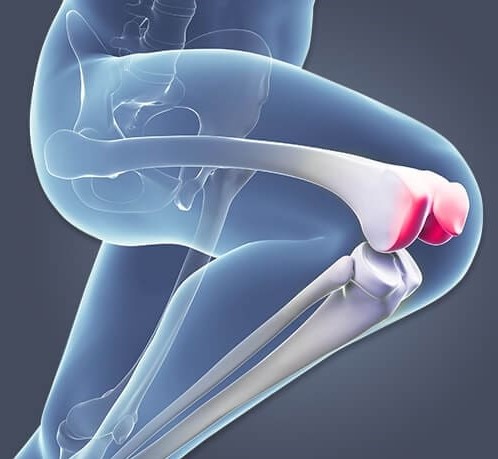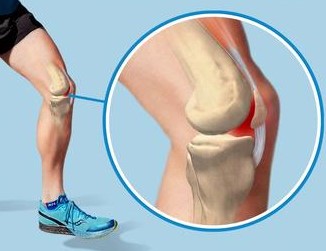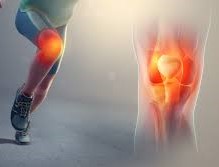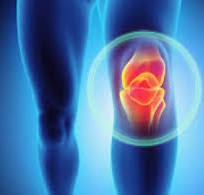Patellofemoral syndrome (Runner's Knee/Anterior Knee Pain)

Patellofemoral syndrome is a broad term which describes pain at the front of the knee due to various knee problems, accounting for around 25% of knee injuries seen by sports therapists. It is known as “runner’s knee” due to the high incidence among runners, but it affects those with both active and sedentary lifestyles.
Runner’s knee is more due to abnormal mechanics than a structural issue with the ligaments and cartilage. The kneecap sits in a groove on the femur (thigh bone) lined with thick cartilage. This groove allows for a wide range of motion of the kneecap, but when an impact hits the knee in a flexed position, eg.while running, this forces the kneecap to bump against the groove, increasing stress on the cartilage and causing pain. Running downstairs/downhill and doing squats will increase the impact.
COMMON MISDIAGNOSIS:-
Runners knee may be incorrectly diagnosed as the following issues which also cause anterior knee pain
• Chondromalacia patella – characterised by actual structural changes in the cartilage lining the kneecap
• Jumpers knee – due to irritation of the patellar tendon just below the knee
• Iliotibial band syndrome - (see previous post)due to irritation of the ITB on the lateral knee

RISK FACTORS:-
• women - due to having wider set hips, improving hip and quad strength should help
• flat feet - rigid arch support in shoes will help
CAUSES:-
• OVERUSE – repeated flexion of the knee high-stress exercises eg lunges, squats
• DIRECT IMPACT to the knee
• CHONDROMALACIA PATELLA - the cartilage below the kneecap breaks down due to friction at the back of the knee
• FOOT PROBLEMS eg. hypermobility, fallen arches, overpronation which affect the gait leading to knee pain
• MALALIGNMENT OF BONES from the hips to the ankles - puts excess pressure on certain areas and the kneecap doesn’t move smoothly in the femoral groove
• INCREASED Q ANGLE (the angle of the thigh bone) - puts more strain on the kneecap, hence why women are affected more
• ANATOMICAL ABNORMALITIES – variations in the shape of the femoral groove and/or kneecap may restrict movement and increase friction due to the two not lining up properly
• MUSCLE TIGHTNESS (hamstrings or hips) – may cause an upward or sideways pulling of the kneecap, increasing pain and friction due to not being able to move properly
• MUSCLE WEAKNESS/IMBALANCE (hips and inner quads) - reduces the support around the knee meaning a higher impact on the kneecap. Muscle weakness on one side of the knee will also cause a slight shift of the kneecap in the groove, resulting in friction
• WEAK GLUTES - runners often have strong hip flexors but weaker glutes, causing inward rotation of the femur which pushes the kneecap to the edge of the femoral groove.
SYMPTOMS:-
Symptoms develop gradually and tend to come and go, but will worsen with:-
• prolonged activity e.g. running long distances or downhill, squatting
• stairs - especially coming down
• sitting for long periods e.g. office workers, driving long distance
The main symptoms are:-
• pain, usually at front of kneecap
• mild swelling around the knee
• popping/grinding feeling in the knee upon movement

TREATMENT:-
• may improve on its own with time
• RICE
- rest the knee, avoid things like running, squatting, lunging, or sitting/standing for long periods of time
- ice to ease pain & swelling for 20-30 minutes every 3-4 hours for 2- 3 days
- compression bandage/knee brace with hole at front to ease pressure/taping for support
- elevate the leg
• anti inflammatories- if there is swelling
• arch supports or orthotics to improve the position of your feet & Q angle, reducing impact on the knee
• strengthening exercises, especially quad muscles & glutes to reduce the stress through the knee & improve the kneecaps position in the groove
• stretching tight muscles to improve the kneecaps position in the groove thus reducing friction
• manual therapy eg. massage to improve any tension or imbalance in muscles
• surgery - severe cases of runner's knee eg. where cartilage is damaged
RECOVERY
Recovery may take between 6weeks & 6 months.
• you can exercise as long as it’s low impact on the joint eg.swimming
• strengthening & stretching exercises may take a few weeks to improve muscle strength
• if you want to run, wear good running shoes & avoid running on hard surfaces which put more impact on the knee
• don't return to workouts before you:-
- can fully bend & straighten the knee without pain
- can walk, run or jump pain free
- your knee is as strong as your uninjured knee
PREVENTION:-
• regular exercise to maintain muscle strength in the thigh
• try to run on softer surfaces that place less impact on the knee
• warm up before working out
• use arch supports if you have foot problems & ensure shoes are supportive & good quality
• replace running shoes once the sole becomes worn or they lose their shape
• wear a knee brace when working out if extra support is needed (a brace with a hole at the front will support while taking the pressure off the kneecap itself)
• maintain a healthy weight
• avoid sudden changes to your workout eg adding squats or lunges

ADVICE FOR RUNNERS:-
• keep your mileage below the pain threshold
• see sports/physiotherapist who can assess your pelvic alignment & recommend a strengthening program to improve the mechanics of the patellofemoral joint
• research shows that women with runner's knee have greater hip instability in their gait – strengthen the hip flexors, glutes & quads
• research also shows that those with runner's knee have a much greater short-term decline in hip strength than those without – exercises to improve hip & core strength
• Research shows that when runners knee is due to overuse (as opposed to trauma)the recovery time is slightly quicker when focusing on hip strengthening as opposed to knee strengthening
STRENGTH EXERCISES:-
WEAK HIPS & INNER QUADS
To improve the alignment of the hip and knee the following exercises can be done either with bodyweight or a resistance band.
• CLAMSHELL - lying on one side, propped up on your forearm, shoulder over elbow & hips stacked. Externally rotate top hip while lifting top knee toward the ceiling, keeping feet together. Lower back down & repeat
• DONKEY KICK - on all fours, shoulders over wrists & knees right under hips. Extend one leg up & back, raising it to hip height with foot flexed. Press heel toward the ceiling, making sure back stays flat & knee points straight down. Lower back to hip height & repeat
• FIRE HYDRANT - on all fours, shoulders over wrists & knees right under hips. Keeping knee bent 90 degrees, lift it out to the side & up toward the ceiling. Make sure you don’t drop into the opposite hip. Lower back down to the floor & repeat.
• STRAIGHT LEG RAISE - sit or lie faceup, legs straight out. Lock out leg as you lift it straight up toward the ceiling. Hold for three to four seconds, then lower back down & repeat. The key is to keep the leg totally straight. Make sure you’re working the vastus medialis by placing your hand on the muscle above the knee, slightly toward your midline. It should activate while you lift & hold your leg.
TIGHT HAMSTRINGS & HIPS
A combination of massage, stretching & foam rolling will prevent & treat muscle tightness by maintaining flexibility.
• Hamstrings stretch - lie on your back & pull one straight leg gently back toward your chest
• Hips - running lunge: one foot in front, place the opposite knee on the ground & press your hips forward, engaging through your back glute
• Piriformis—figure four stretch: lying on your back, cross left ankle over right knee, grab the back of the right thigh & pull it toward your chest
• Tennis ball to roll out the posterior glutes
• Foam roller for quads, IT band, hamstrings
MASSAGE FOR RUNNERS KNEE
Massage is effective in relieving pain associated with runner’s knee, by stretching & loosening muscles around the knee. It also helps to improve the alignment of tendons and muscles around the hips and knees which may help reduce recovery time.
Common types of massage for runner’s knee includes:
● Deep tissue massage
● Sports massage
● Trigger point massage
As always, ensure that you see a registered therapist.
